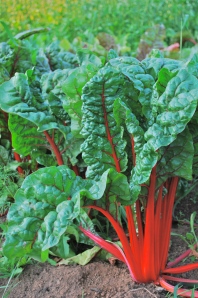Sol Food
When we think of sunshine foods, we default to adjectives like fruity, floral, and exotic. We imagine coconuts, passion fruit, and peppers rather than cabbage, lettuce, or kale. Though mango and pineapple do not survive this northerly climate, our own brand of sun-steeped harvests makes its appearance this time of year.
Falling between June 20th and 21st, the solstice represents more than opening day of summer shenanigans. Denoting the sun’s longest journey across the sky, the summer solstice is also known to gardeners as the time of endless greens—bottomless heads of lettuce, kale with wide paddles for leaves, unrestrained growth in every direction.
Though the solar calendar says it’s summer now, our climate tends to linger in the doorway a bit longer, extending spring showers and cool temperatures intermittently into early July. This oscillation of warm, sunny stretches and cooler, rainy days helps to check the growth of these greens, allowing them to take full advantage of mid-June’s extra long days.
Our lengthiest day of the year totals just short of sixteen hours of sunlight. To a plant’s physiology, extending day length is akin to increasing production hours. The chlorophyll in plant leaves is active in the presence of sunlight; the more sun there is, the more energy a plant is capable of synthesizing.
Plants invest some of the season’s surplus energy into creating more chlorophyll (and therefore more surface area, i.e. larger leaves), which in turn both creates an ability to manufacture more stored energy and a need for someplace to store it. In step luscious root crops like beets, radishes and turnips that seem to materialize over night as the solstice nears—the latter two transforming from tiny seeds to hefty bundles in under a month.
The whole garden is a rowdy place in June. What was freshly turned soil studded with seedlings becomes a bubbling quilt of colors and textures, plants touching shoulders with infectious camaraderie, vines tangled and climbing toward the sun that fuels them. Even slowpokes like carrots, potatoes, and onions seem inspired to catch up to their neighbors.
Perhaps the same spirit that infects the vegetables rouses the gardener as well, and perhaps some of the affection we have for this season comes from the sun’s penchant to party. We feel an urge to get out, to see, to commune and celebrate, to sit in the sun’s radiance. A garden in solstice is that urge made visible, and an appeal to find numerous and interesting ways to prepare a salad, to cook a turnip, to embellish kale or mustard greens or cabbage.
We are lucky to live in a place where we can grow tasty greens year-round, but I think solstice greens are the finest—tender and succulent in their freshness, glowing with the deep, verdant pigments of ample sunlight and water. No trials of heat or cold to endure, they open to their fullest, most vulnerable beauty.
It is easy to feel overwhelmed by a garden, for the undesirables grow as quickly as the desirables, and I am often overwhelmed until a wave of summer heat tempers the revelry. But in that heat, I begin to miss those soft, sweet leaves and the lush, hulking garden that produced them. So I try to savor every bit of it now, weeding and eating my way through these long, exquisite days.

